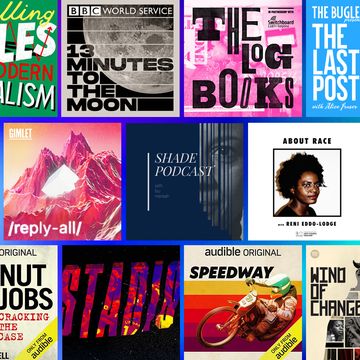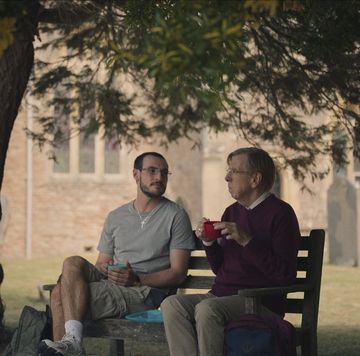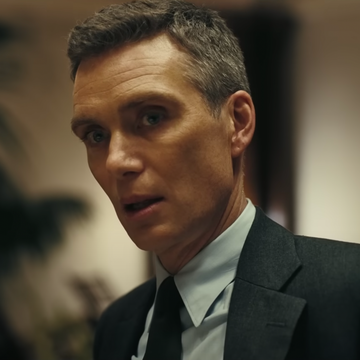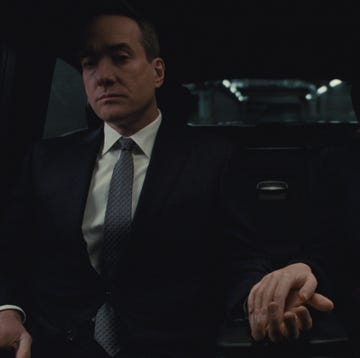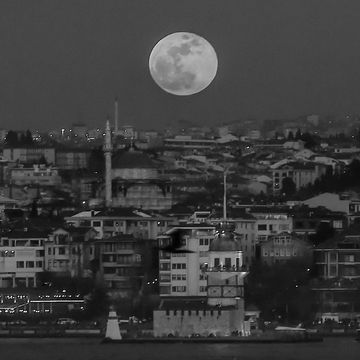The first image we see on Sharp Objects is a needle slowly descending onto a warped record. The warbling sound of Franz Waxman’s theme from A Place in the Sun plays as pastoral images of rural Missouri drift across the screen. By the beginning of the second episode—after we’ve seen multiple gruesome murders—that needle drops again, but this time to a modern electronic track. It sounds like an entirely new song. But, if you listen closely beneath the pulsing floor drums and synth bass, you’ll hear a familiar melody. It’s “A Place in the Sun,” barely recognisable, hiding beneath a modern treatment by Jeffrey Brodsky.
“A lot of people miss that,” says music supervisor Susan Jacobs. “They're like, ‘Why do you have a different song?’ It's not, it's a different interpretation.”
By Episode Three, it’s a lonely piano version. In Episode Four, it’s hip-hop. And so on.
That musical motif plays a pivotal role in Sharp Objects both thematically and aesthetically, and it has a personal history that goes back decades with director Jean-Marc Vallée. Vallée's ability to integrate music so powerfully into his work was also apparent to Led Zeppelin—a band famously picky about relinquishing rights to film and TV projects—who allowed the series unprecedented use of their discography.
When Vallée was a teenager growing up in France, he’d watch Michel Boujut’s TV documentary Cinema Cinemas, which would open with Waxman’s theme.
“I watched them over again to listen to what I love. There's this theme coming back again. It’s beautiful,” Vallée says. “Over the years, I thought we should try to create a theme like this—it's so romantic.”
At the time of its release, A Place in the Sun had the longest kiss in the history of cinema between Montgomery Clift and Elizabeth Taylor, Vallée tells me. “People were shocked. Oh my god, they're opening their mouth and kissing, so long.”
This idea, this musical romanticism, became the basis for the Sharp Objects character Alan Crellin (Henry Czerny), who sits lonely at his stereo (which has become the envy of audiophiles) playing starry-eyed classics.
“It makes Alan dream—this theme that he saw in the films, and then to use this theme as our main title sequence, the irony,” Vallée says. “Again, focusing on something beautiful, romantic, while we know we're telling such a dark, brutal story, human story. We love that contrast.”
But beneath the beauty is something sinister. Alan, for example, plays the perfect husband to the perfect wife, but as the lights go down in that big Wind Gap house, his wife refuses to touch him. Sharp Objects is a show that demonstrates how the failures of our parents can cut lifelong wounds into their children; the Crellin family is haunted by the death of their young daughter, which has literally and emotionally scarred Amy Adams’s Camille, while her mother’s oppressive socialite behaviour has encouraged the dangerously rebellious nature of Amma, their youngest.
In a party scene in Episode Six, Amma and her two friends put on Engelbert Humperdinck’s version of “Can’t Take My Eyes Off of You.” They’re fucked up, having gotten drunk and taken acid and painkillers, spinning in the middle of the party while their friends protest. The killer could be somewhere in that crowd, giving the song’s lyrics a menacing tone in this scene. And meanwhile, Humperdinck is a regular sound in the Crellin household, a '60s singer who is spun on Alan’s record player in earlier episodes.
This type of nuanced soundtracking is a familiar trait of Vallée’s earlier work as well. Last year's spring hit Big Little Lies was largely defined by its music, which became as popular a conversation as the central murder mystery. That soundtrack from Vallée and music supervisor Susan Jacobs, who is also behind Sharp Objects, introduced audiences to a lush tapestry of soul and blues, both old and contemporary. The show boosted the popularity of Michael Kiwanuka and Leon Bridges. That music was as important as anything, building the atmosphere from headphones and speakers, where the characters listen along with the audience.
Sharp Objects uses music in a similar way, with an obsessively curated soundtrack that places the audience in each scene. “If they're in a car, music comes from shitty speakers in the car. If they're in a bar, it comes from speakers in the bar. When it comes from Alan's room, it's a better sound,” Vallée says. “But it always comes from somewhere in the room, you know, like a score.”
The characters in Vallée’s work are in-part defined by the music they listen to. Notice the difference between what Camille’s editor, Curry, listens to and what is played in the bar or in Alan’s room. In Camille’s case, the music was harder to define.
“There's something vintage about Camille, and something where she doesn't wanna be fashionable,” Vallée says. “She's rejecting the establishment, she's different.” He decided that she wasn’t someone who cared about music. Instead, music came to her. In the third episode, we learn exactly why Led Zeppelin is always Camille’s go-to band to cue up on her cracked iPod when she gets in her car. While in a medical facility, where she’s placed because of her history of self-harm, she bonds with her young roommate, who introduces her to the band. Tragically, the girl dies by suicide while in the medical facility—a moment that changes Camille's life, and causes Zeppelin to become a form of self-medication for Camille used to cope with her pain. “She learns to use music as a way to get out of here whenever she wants,” Vallée says.
Vallée decided that this escape had to be Led Zeppelin, a band that, to him, represents individuality and an anti-establishment energy. The problem was it’s notoriously hard to get the rights to their songs. The movie Dazed and Confused famously doesn’t include the titular song because director Richard Linklater couldn’t procure the rights to it.
“It's kind of like a music supervisor's nightmare when directors go, 'What do you think about Led Zeppelin?'” Jacobs says. Even if a production can get a song, that’s the limit. Yet, she got to work crafting a pitch for the band members to approve.
“We were trying to explain the importance of what music really does and how it plays a really pivotal role in this girl's life,” Jacobs says, “and also the escapism idea of music.”
Miraculously, the band liked the idea so much they approved not one but four songs; they also gave Vallée free reign to play as much of the tracks as he wanted and even layer them over each other to make his own atmosphere. “I think I fell on the floor,” Jacobs says of when she got the call, hearing that the songs had been approved. “Like, wow, this was so unprecedented, because they rarely ever let you use more than one song, and [we could] use the songs multiple times.”
The difference with Sharp Objects was Vallée’s approach to his soundtracks, which isn’t music as background music, but rather an integral part of the story and characterisation.
“They came on board knowing how Jean-Marc is. They understood his style and that’s really important,” Jacobs said. “That's their whole motivation for making music, it's to communicate, like any artist. They're just trying to communicate with other people. And the fact that this is somebody saying music is just a lot deeper and a lot more meaningful than just charts or sales or background sounds.”
As such, like the Place in the Sun theme, Zeppelin has become the sound of the miniseries, which Vallée teases will return in the final episode at a pivotal moment.
With two episodes remaining in the mini-series, anyone looking to delve a little further into the mystery of Sharp Objects should listen closely to the music. As Vallée and Jacobs note, they’ve intentionally placed songs that repeat the word, "mama" throughout the series, which speaks to Camille and Amma’s embattled relationship with their mother, and, potentially, something more sinister.
“The first goal is to touch the heart,” Vallée explains. “But then, once you start to analyze and to think deep down, you go, oh there's this and that, there's this, there's always a reason why these songs are there. Sometimes it's for the beauty of the melody, or for their lyrics, or for the specific atmosphere.”
Matt Miller is a Brooklyn-based culture/lifestyle writer and music critic whose work has appeared in Esquire, Forbes, The Denver Post, and documentaries.


